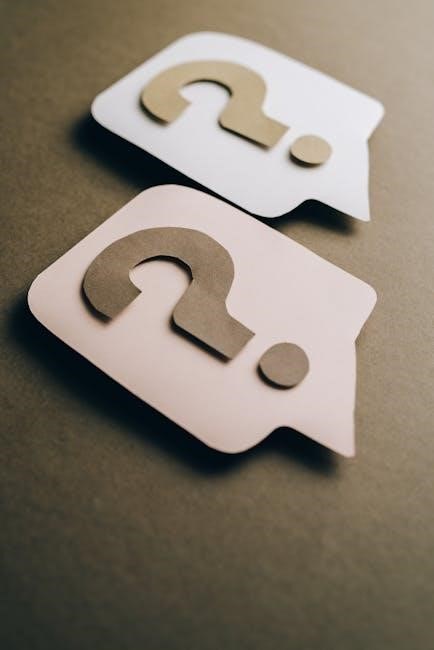Explore fascinating facts about U.S. presidents with this curated collection of trivia questions and answers, perfect for history enthusiasts and educational purposes.
Covering presidents from George Washington to modern leaders, this PDF offers engaging Q&As on historical events, unique presidential facts, and lesser-known stories.
Ideal for quizzes, classroom activities, or casual trivia nights, this resource provides a fun and informative way to learn about America’s leadership history.
Overview of Presidential Trivia
Presidential trivia offers a captivating way to delve into the lives and legacies of U.S. leaders, spanning from the nation’s founding to modern times.
These questions and answers cover a wide range of topics, including historical events, unique presidential facts, and lesser-known anecdotes about America’s commanders-in-chief.

Whether it’s George Washington’s leadership during the Revolutionary War or Franklin D. Roosevelt’s New Deal, this collection provides insights into the decisions, challenges, and personalities that shaped the country.
Importance of PDF Format forTrivia Questions
Importance of PDF Format for Trivia Questions
The PDF format is highly advantageous for presenting presidential trivia questions and answers due to its universal accessibility and consistent formatting.
PDFs can be easily downloaded, printed, or shared across devices, making them ideal for quizzes, educational materials, or casual trivia nights.
The format ensures that the layout remains intact, preserving the clarity of questions and answers, while also allowing for visually appealing designs that enhance the learning experience.
Early Presidents of the United States
Discover the fascinating stories of America’s founding leaders, from George Washington to Thomas Jefferson, who shaped the nation’s early years and set its foundation.
Who Was the First President Born in Hawaii?
Barack Obama is the first U.S. president born in Hawaii. Born on August 4, 1961, in Honolulu, he became the 44th president in 2009. His unique background, with a father from Kenya and a mother from Kansas, reflects America’s diverse heritage. Obama’s presidency marked significant milestones, including healthcare reform and progressive social policies. His birthplace in Hawaii adds to the fascinating trivia surrounding his historic role as the first African American president and a symbol of change in American political history.
Which President Is Known as the Father of the Constitution?
James Madison is widely recognized as the “Father of the Constitution” for his pivotal role in drafting and promoting the U.S. Constitution. His leadership at the Constitutional Convention in 1787 and his advocacy for a strong central government were instrumental in shaping the document.
Madison also played a key role in the Bill of Rights, ensuring its ratification as the first ten amendments. His contributions to American governance and constitutional law remain unparalleled, solidifying his legacy as a foundational figure in U.S. history.
Who Was the First President to Die in Office?
William Henry Harrison was the first U.S. president to die while in office. He served the shortest tenure in presidential history, dying just one month after his inauguration on March 4, 1841. Harrison delivered the longest inaugural address on a cold, wet day without wearing a coat, leading to a severe cold that developed into pneumonia. His untimely death marked a tragic beginning to his presidency and set a somber precedent for future leaders.

Presidents and Their Unique Facts
Discover intriguing anecdotes about U.S. presidents, such as who got stuck in a bathtub, who served non-consecutive terms, and which leader was known as “Silent Cal.”
Which President Got Stuck in a Bathtub?
William Howard Taft, the 27th U.S. President, famously got stuck in the White House bathtub due to his large size. Weighing over 350 pounds, the tub was too small, leading to embarrassing incidents. This situation prompted the installation of a larger, custom-made tub to accommodate him comfortably. Taft’s weight-related challenges became a notable anecdote in presidential history, highlighting both the practical challenges faced by larger individuals and the adaptive measures taken to address them. This unique fact remains a popular trivia question about U.S. presidents.
Who Was the Only President to Serve Two Non-Consecutive Terms?
Grover Cleveland holds the distinction of being the only U.S. President to serve two non-consecutive terms. He was elected as the 22nd President in 1884, lost re-election in 1888, and then won again in 1892, becoming the 24th President. This unique circumstance led to his two terms being counted separately, making him the only president with such a non-traditional tenure. Cleveland’s political resilience and voter support during challenging economic times contributed to his historic re-election, setting him apart in American political history.
Which President Was Known as Silent Cal?
Calvin Coolidge, the 30th U.S. President, earned the nickname “Silent Cal” due to his reserved and quiet nature. Known for speaking sparingly, Coolidge believed actions spoke louder than words. His minimalist communication style endeared him to the public, reflecting his humble and practical approach to governance. During his presidency, he focused on small government, tax cuts, and economic growth, leaving a legacy of simplicity and integrity. Coolidge’s nickname remains a testament to his unique personality and leadership style, making him one of America’s most memorable leaders.

Civil War and Reconstruction Era Presidents
The Civil War and Reconstruction era saw pivotal leadership, with Abraham Lincoln guiding the nation through its greatest crisis. Andrew Johnson oversaw Reconstruction, while Ulysses S. Grant enforced policies to reunify the nation, shaping America’s future.
Who Was the President During the Civil War?
Abraham Lincoln served as the 16th President of the United States during the Civil War, leading the nation from 1861 until his assassination in 1865. His leadership was crucial in preserving the Union and ending slavery. Lincoln’s Emancipation Proclamation and Gettysburg Address remain iconic moments in American history, showcasing his commitment to unity and freedom. His presidency laid the foundation for Reconstruction and continues to inspire Americans today.
Which President Issued the Emancipation Proclamation?
Abraham Lincoln, the 16th U.S. President, issued the Emancipation Proclamation on January 1, 1863. This historic document declared freedom for enslaved individuals in Confederate states, paving the way for the eventual abolition of slavery. Although it didn’t immediately free all slaves, it changed the war’s purpose and set the stage for the 13th Amendment. Lincoln’s bold action remains a pivotal moment in the fight for equality and human rights in American history.
Who Was the President After the Civil War?
Andrew Johnson became President after the Civil War, succeeding Abraham Lincoln who was assassinated in April 1865. Johnson, the 17th U.S. President, oversaw the Reconstruction era, aiming to reintegrate the South into the Union. His presidency was marked by tension with Congress over Reconstruction policies. In 1868, Johnson was impeached by the House of Representatives but was acquitted by a single vote in the Senate, allowing him to complete his term. His leadership during this critical period shaped the nation’s post-war trajectory.

20th Century Presidents
Discover intriguing facts about 20th-century U.S. presidents, from Theodore Roosevelt’s progressive reforms to Ronald Reagan’s Cold War leadership, highlighting their unique impacts on American history.
Who Was the First President to Resign?
Richard Nixon holds the distinction as the first U.S. president to resign from office. Facing impeachment due to the Watergate scandal, Nixon stepped down on August 9, 1974, marking a significant moment in American political history. His resignation underscored the constitutional process of accountability, ensuring the continuity of democratic governance. Gerald Ford succeeded him, becoming the 38th President of the United States. This event remains a pivotal example of leadership crisis and resolution in the nation’s history.

Which President Led the Country Through the Great Depression?
Franklin D. Roosevelt (FDR) led the United States through the Great Depression, implementing transformative policies known as the New Deal. Elected in 1932, FDR introduced programs like the Civilian Conservation Corps and the Works Progress Administration to create jobs and stimulate economic recovery. His leadership and reforms helped stabilize the economy and restore public confidence during one of America’s darkest periods. FDR’s presidency marked a significant shift in federal government involvement in economic and social affairs, leaving a lasting legacy in American history.
Who Was the Youngest Elected President?
John F. Kennedy (JFK) holds the distinction as the youngest elected president in U.S. history. At just 43 years old, he won the 1960 presidential election. His youthful energy and visionary leadership captivated the nation, earning him the nickname “The King of Camelot.” Despite his tragic assassination in 1963, JFK’s presidency remains memorable for its ambitious initiatives, including the New Frontier and the Apollo space program. His legacy continues to inspire, making him one of America’s most iconic leaders.

Presidents and Their Legacies
Explore how U.S. presidents have left lasting impacts through their policies and decisions, shaping the nation’s history and future generations.
Who Was the First President to Win the Nobel Peace Prize?
Theodore Roosevelt, the 26th U.S. President, was the first to receive the Nobel Peace Prize in 1906. His efforts to end the Russo-Japanese War through mediation led to this honor, showcasing his commitment to international diplomacy. Roosevelt’s leadership in foreign affairs and his belief in negotiation over conflict were key factors in this recognition, making him a significant figure in both American and global history.
Which President Signed the Sherman Anti-Trust Act?
Benjamin Harrison, the 23rd President of the United States, signed the Sherman Anti-Trust Act in 1890. This landmark legislation aimed to prohibit monopolistic business practices and promote competition. Harrison’s support for the act reflected his commitment to fair business practices and addressing public concerns over corporate power during his presidency.
Who Was the First Catholic President?
John F. Kennedy was the first Catholic to be elected President of the United States. His historic victory in 1960 marked a significant milestone in American political history, breaking down religious barriers. Kennedy’s faith played a role in shaping his policies and public image, making his presidency a pivotal moment for Catholic Americans and the nation as a whole.

Modern Presidential Trivia
Discover intriguing facts about recent U.S. presidents, including their unique achievements, policies, and personal anecdotes that shape modern American history and political culture.

Who Was the First President to Use Social Media Extensively?
Barack Obama is widely regarded as the first U;S. president to extensively use social media. During his 2008 campaign and presidency, he leveraged platforms like Twitter, Facebook, and YouTube to connect directly with the public, share policy updates, and engage in real-time conversations. This approach marked a significant shift in political communication, setting a precedent for future leaders to embrace digital platforms as key tools for outreach and transparency.
Which President Oversaw the Move of the U.S. Embassy to Jerusalem?
President Donald Trump oversaw the relocation of the U.S; Embassy from Tel Aviv to Jerusalem in 2018. This decision, a fulfillment of a campaign promise, was controversial and significant, as it recognized Jerusalem as Israel’s capital. The move was met with both praise from pro-Israel groups and criticism from others, who feared it could disrupt peace efforts in the region. The embassy officially opened on May 14, 2018, marking a historic shift in U.S. foreign policy regarding the Israeli-Palestinian conflict.
Who Is the Oldest Living President?
Jimmy Carter, the 39th President of the United States, is the oldest living president, born on October 1, 1924. As of now, he is 99 years old. Known for his dedication to public service and humanitarian work, Carter has remained active in various initiatives long after his presidency. His legacy includes significant contributions to global health and democracy, earning him a Nobel Peace Prize in 2002. Carter’s longevity and continued impact make him a remarkable figure in American history.

Creating Your Own Presidential Trivia Quiz
Design engaging questions covering presidents’ lives, policies, and unique facts. Use credible sources for accuracy. Format your quiz in PDF for easy sharing and printing.
How to Design Engaging Questions
Start by balancing easy and hard questions to cater to all knowledge levels. Focus on unique presidential facts, surprising anecdotes, and historical milestones. Use clear, concise language and avoid ambiguity. Incorporate multimedia elements like images or quotes for visual appeal. Group questions by themes, such as early presidents or modern leaders, to maintain flow. Add a mix of multiple-choice and open-ended questions to keep it dynamic. Ensure accuracy by cross-referencing credible sources. Make it fun by highlighting quirky or lesser-known facts about presidents’ lives and legacies.
Where to Find Reliable Information
Utilize reputable sources like Parade.com, Smithsonian books, and official historical records for accurate presidential trivia. Cross-reference with Britannica.com and History.com for verification. Incorporate educational resources from History.com, NationalGeographic.com, and WhiteHouse.gov for reliable data. Consider academic databases like JSTOR for in-depth articles. Ensure information is current and verified to maintain accuracy in the trivia content.
How to Format Your Quiz in PDF
Organize your quiz with clear sections, using bold headers for questions and italicized text for answers. Number each question and separate answers on a dedicated page or section. Use bullet points for multiple-choice options and ensure readability with a clean font. Include a cover page with a title and instructions. Save as a PDF for easy sharing and printing, ensuring compatibility across devices. This format makes your quiz user-friendly and visually appealing for participants.
Presidential trivia questions and answers offer a fun and educational way to explore U.S. history, making learning engaging and accessible for all ages.
The Value of Presidential Trivia for Educational Purposes
Presidential trivia questions and answers are a dynamic tool for engaging students in U.S. history, fostering critical thinking, and enhancing retention of historical facts. By presenting information in a fun, quiz-like format, these resources simplify complex topics, making them accessible to all skill levels. They encourage active learning, spark curiosity, and provide a comprehensive overview of presidential legacies, policies, and personal anecdotes. Educators can integrate these quizzes into lesson plans to create interactive and memorable learning experiences, enriching students’ understanding of America’s past and present leadership.
Final Thoughts on Exploring Presidential History
Delving into presidential trivia offers a captivating way to understand U.S. history, leadership, and democracy. These questions and answers reveal the unique personalities, pivotal decisions, and lasting impacts of America’s leaders. By exploring these facts, readers gain insight into the nation’s evolution and the role of the presidency. The PDF format makes this knowledge accessible and engaging, encouraging both casual learners and scholars to reflect on the past. Whether for education or entertainment, presidential trivia fosters a deeper appreciation for the complexities of American history and its enduring influence on modern society.